-
1. Exam (elaborations) - Final exam radt 400 questions with verified answers
-
2. Exam (elaborations) - Radt 64 exam questions and answers
-
3. Exam (elaborations) - Radt 100 final exam questions with correct answers
-
4. Exam (elaborations) - Radt 101 (20 question test) final exam question s and answers
-
5. Exam (elaborations) - Radt 101 midterm exam questions with latest update
-
6. Exam (elaborations) - Radt 101 practice final exam questions with latest update
-
7. Exam (elaborations) - Radt 152- unit 1 exam questions with latest update
-
8. Exam (elaborations) - Radt 151 test exam questions and answers
-
9. Exam (elaborations) - Radt 150 final exam questions with latest update
-
10. Exam (elaborations) - Radt 146 unit 1 test exam questions and answers
-
11. Exam (elaborations) - Radt 142c unit 1 exam questions and answers
-
12. Exam (elaborations) - Radt 142 test 1 exam questions and answers
-
13. Exam (elaborations) - Radt 132 test 1 review exam questions with correct answers
-
14. Exam (elaborations) - Radt 111 patient care final exam study guide questions and answers
-
15. Exam (elaborations) - Radt 153c unit 5 exam questions and answers
-
16. Exam (elaborations) - Radt 156- exam 1 review questions with correct answers
-
17. Exam (elaborations) - Radt 157 exam 3 questions with verified answers
-
18. Exam (elaborations) - Radt 162 exam 1 questions with latest update
-
19. Exam (elaborations) - Radt 221 test 1 ch 3-4 exam questions and answers
-
20. Exam (elaborations) - Radt 241 test review exam questions and answers
-
21. Exam (elaborations) - Radt 251 final review exam questions with latest update
-
22. Exam (elaborations) - Radt 253 exam questions with latest update
-
23. Exam (elaborations) - Radt 253 test #2 exam questions and answers
-
24. Exam (elaborations) - Radt 253 test #3 exam questions and answers
-
25. Exam (elaborations) - Radt 1010 - exam 1 questions with correct answers
-
26. Exam (elaborations) - Radt 1000 final exam questions with correct answers
-
27. Exam (elaborations) - Radt 435 exam 2 questions and answers
-
28. Exam (elaborations) - Radt 435 exam 1 questions and answers
-
29. Exam (elaborations) - Radt 430 final exam questions with latest update
-
30. Exam (elaborations) - Radt 410 final exam questions with correct answers
-
31. Exam (elaborations) - Radt 400 review exam questions with complete solutions
-
32. Exam (elaborations) - Radt 400 - exam 2 questions and answers
-
33. Exam (elaborations) - Radt 1010 final exam study guide questions and answers
-
34. Exam (elaborations) - Radt 1010 final review exam questions with latest update
-
35. Exam (elaborations) - Radt 1010 test 2 exam questions and answers
-
36. Exam (elaborations) - Radt 1022 exam 1 questions with latest update
-
37. Exam (elaborations) - Radt 1060 final (procedures) exam questions with latest update
-
38. Exam (elaborations) - Radt 1065 final exam questions and answers
-
39. Exam (elaborations) - Radt 1075 exam #1 questions and answers
-
40. Exam (elaborations) - Radt 1075 final exam questions and answers latest update
-
41. Exam (elaborations) - Radt 1085 final exam questions with latest update
-
42. Exam (elaborations) - Radt 1200 final exam questions and answers
-
43. Exam (elaborations) - Radt 1200 final exam questions with complete solutions
-
44. Exam (elaborations) - Radt 1725 final exam question with correct answers
-
45. Exam (elaborations) - Radt 2042 patient care final exam questions with correct answers
-
46. Exam (elaborations) - Radt exam questions and answers
-
47. Exam (elaborations) - Radt final exam questions and answers
-
48. Exam (elaborations) - Radt final exams questions and answers
-
Show more




